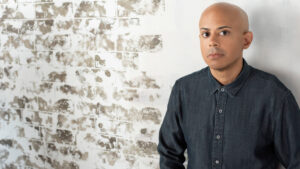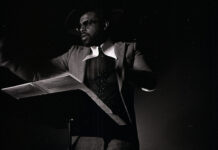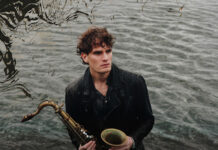
Last Saturday classical pianist/composer Stewart Goodyear gave the world premiere of his piano concerto with the Albany Symphony. This Saturday he will perform a recital at The Wallis Annenberg Center for the Performing Arts in Beverly Hills that will feature music found on his 2021 album Phoenix. Then he’s on the road playing Beethoven, Tchaikovsky, Ravel and more.
In early 2023, he will give the world premiere performance of a new work for piano and jazz musicians at the Royal Conservatory of Music in Toronto where Goodyear serves as its inaugural Artist-in-Residence.
Since bursting on the scene he’s become celebrated for his unique interpretations of the classical repertoire and also for performing all 32 of Beethoven’s sonatas in a single day. The composer’s notoriously difficult Sonata No. 29 in B-flat Major, aka Hammerklavier, is on his recital program at The Wallis.
Last month I spoke via Zoom with Goodyear about his piano concerto, what his writing reveals about who he is and about Beethoven’s Hammerklavier. What follows are excerpts from that conversation that have been edited for length and clarity. To see the full interview, please go to our YouTube channel.
Eleven years ago you told CBC’s Manitoba Scene, “When it comes to enthusiasm for performing for the audience, the secret is always to remember why one became a musician in the first place and keeping that joy and that passion alive.” The world has been through so much since you said that and you’ve also made some significant changes in your career during that time. Do you still feel that way and what are the challenges of keeping that passion alive?
I don’t think there are challenges. It’s always a lot of work and it’s always bringing your best game to every concert because the audience deserves that. It’s always a new encounter. It’s always the postcard for that time, that event. I take every single concert very seriously because I love sharing myself with the audience. The audience shares themselves with me with the vibe that they give. From there is a collaboration that occurs. That passion never dies.
What is it you think the audience learns about you through a given performance?
That is a very good question. I hope that through our collaboration we get to learn from each other. I know for me I learn a lot about the audience. I feel like every single time I perform it’s always a learning experience because they always bring me something new and it’s always organic. I’m hoping that what the audience gets from me is just my love for the whole experience.
You have a lot of big moments coming up and I want to talk about two of them. One is that the Albany Symphony is going to be giving the world premiere of your piano concerto. How did you approach this composition and what did you want to express with it?
This was a piece that was a very vulnerable project because this was the first time that I was actually writing a vehicle for myself. When it came to other works for piano and orchestra, I was always looking at it from a composer’s hat. When I wrote Callaloo it was very much thinking about paying homage to my Trinidadian background. This is strictly a piano concerto. Taking the plunge with that genre and remembering, but also erasing, the whole history so that I could just approach this piano concerto with fresh eyes was something that was a very exciting project.
Anthony Tommasini of the New York Times did an interview with you last year where you were talking about your approach to playing as “going through everything, finding my own truth as well as respect the tradition, the gestures, the music that inspired the composers.” it was that last bit that really stood out to me as you have written a piano concerto. What is the music that inspired you as a composer for this concerto and how does that get layered into not just what you wrote, but how you play it?
With how I’ll play it, it really is going to be interesting in terms of [how] Maestro David Alan Miller and I work together. My inspiration was just going to a friend’s house and, believe it or not, my inspiration was eighties to 2022’s pop music and almost being like a pianist at karaoke where I got to find out a lot about every genre from country music to rap and how every single world has their own set of rules when it comes to harmony and how one chord goes on to the next. It was something that I was not conscious of until that period. That was how the concerto came to be and the inspiration came from there.
The behemoth on your Wallis recital is, of course, the Beethoven Hammerklavier Sonata 29 in B-flat Major. I was able to find out what Beethoven’s Viennese publishers wrote when they announced this new sonata in 1819. They called it a work that “excels above all other creations of this master, not only through its most rich and grand fantasy, but also in regard to artistic perfection and sustained style and will mark a new period in Beethoven’s pianoforte works.” What sets this sonata apart from all others that Beethoven wrote and were his publishers right?
I think his publishers were absolutely right. I think with every sonata that Beethoven wrote they were gems. It was always Beethoven pushing himself to see where he will go. There was never a safety net with any of those works. With the Hammerklavier, I think until the last three sonatas, that was the most adventurous work he created. It uses the entire keyboard of his piano. It pushes the limits between the softest and the loudest. There [are] technical hurdles. There are jumps and it’s almost as if it’s way ahead of its time because it’s definitely a work that could speak to the audience of 2022 because there’s so much information that happens in such a small period of time. I think every five seconds can be a very exciting ticktock. It doesn’t stop – even in the slow movement. It never rests. It’s filled with emotion. It pours out every crevice of emotion. The last movement is filled with defiance. It goes upside down. It goes backwards. An inexhaustible amount of genius for every second of that work.
You were given two weeks by Leon Fleisher to learn this work when you when you were studying with him and first learning it. How has your relationship with Hammerklavier evolved since you first learned it?
I was trying to honor the metronome markings. When I was a student there was always this idea that Beethoven didn’t know what he was doing. It was always played a lot slower. Because it was the Mt. Everest of of sonatas, people always treated it like a mountainous opus in every single sense of the word, almost to the point where it was so heavy. During the time when I was learning the piece I was always rebelling against that interpretation and I wanted to crack the mystery behind those metronome markings.
But I didn’t quite get it yet. I was just going this makes sense, I just need to find my way around it. Nothing is impossible. I thought instead of thinking about this as this mammoth, gargantuan opus, why not think of it merely as another exciting opus; another exciting chapter in Beethoven’s life. I felt like every time Beethoven was writing he was getting younger and younger and more adventurous. He was never retiring. He was always hungry. I thought if I put it in that frame, what can I do?

That’s how I came up with the first movement could easily be in that metronome marking like a homage to Baroque. It could easily be like a Vivaldi concerto where there’s a beauty, then there’s a solo, then there’s like a concerto grosso that goes on there. For the second movement I thought this is comedy. Beethoven absolutely loved comedy. There was no high brow or low brow. It was all about delivery. The third movement is a long work, but it shouldn’t feel like a long work. It should just make you weep. The performer has to be so in tune with every listener in order to bring that pain, that vulnerability, that passion across. And then the fourth movement. It’s just going nuts. What the heck was Beethoven up to? This was crazy.
Did you come up with an answer to that question?
Even when Beethoven [has] a dark cloud it is never a dark cloud that’s gloomy. There’s an anger, but it’s an anger that’s like, “Come on! We can do better. Why are we not doing better?” It’s always this light at the end of the tunnel that Beethoven is trying to fight towards to get to.
Beethoven said, “Don’t only practice your art, but force your way into its secrets.” Now you have the world premiere of your piano concerto. You have the Royal Conservatory of Music premiere in January. What are the secrets of your art that might be found in your compositions that you hope will continue to be discovered long after you’re gone?
I’ll put it this way. There’s always an idea of streaming against the mainstream. From there you find your own identity, you find your own truth, your find your own individuality. That’s always something that consciously or unconsciously was something that was always a part of my makeup. I hope I bring that to every piece I write because that’s me.
To watch the full interview with Stewart Goodyear, please go here.
Stewart Goodyear will perform Beethoven’s Piano Concerto No. 4 with the Nashville Symphony on November 4th and 5th; a recital at Miossi Hall Performing Arts Center in San Luis Obispo on November 6th; The Nutcracker Complete Ballet Arranged for Solo Piano at Wake Forest University on November 15th; Ravel’s Piano Concerto for the Left Hand with the Baltimore Symphony Orchestra on November 17th and 20th. For tickets and more information about the world premiere with the Royal Conservatory of Music, please go here.
All photos by Anita Zvonar/Courtesy Colbert Artists











